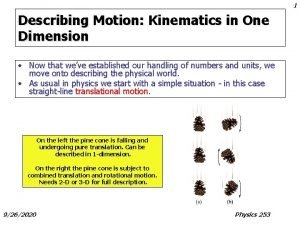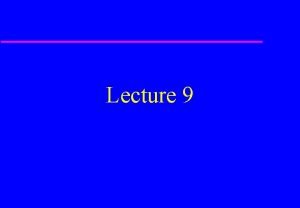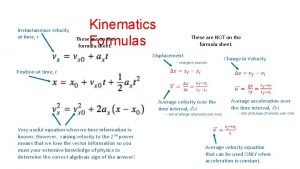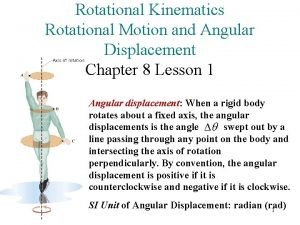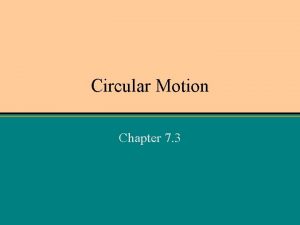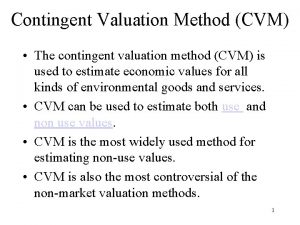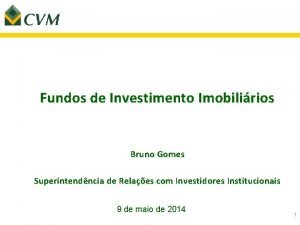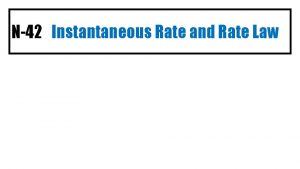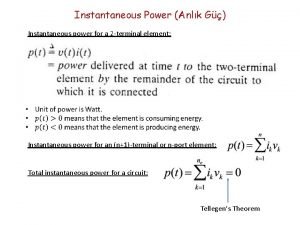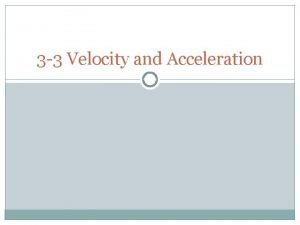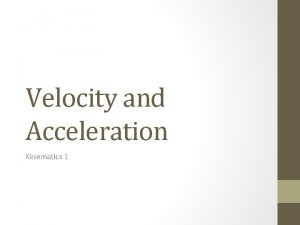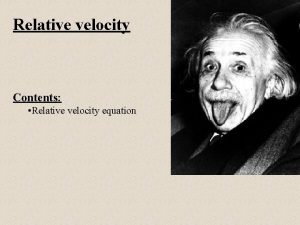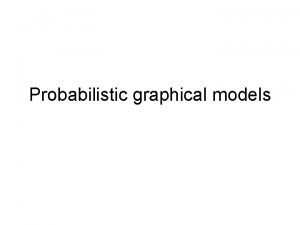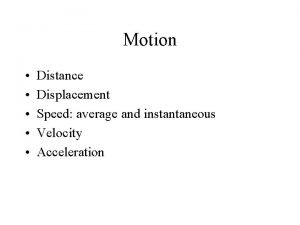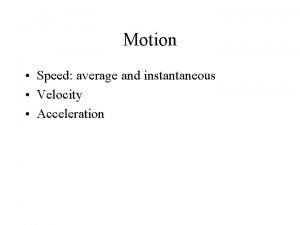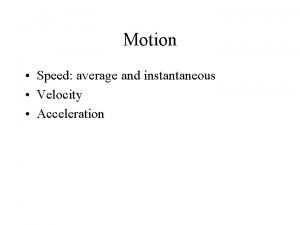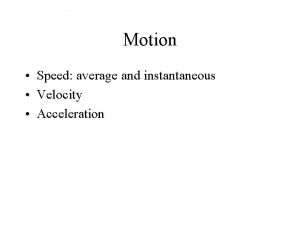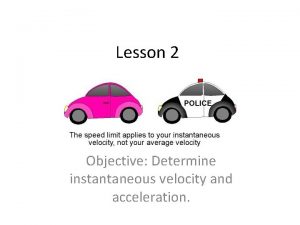UNIT 2 CVM INSTANTANEOUS VELOCITY AND GRAPHICAL REPRESENTATIONS




















- Slides: 20

UNIT 2 CVM INSTANTANEOUS VELOCITY AND GRAPHICAL REPRESENTATIONS OF POSITON VS. TIME

OBJECTIVES • I CAN… • IDENTIFY AN OBJECT’S DIRECTION OF MOTION, INITIAL POSITION, AND RELATIVE SPEED FROM A POSITION VS. TIME GRAPH • SOLVE FOR TIME, VELOCITY, OR DISTANCE IN PROBLEMS USING THE CONSTANT VELOCITY EQUATION • DRAW 2 GRAPHICAL REPRESENTATIONS OF AN OBJECT’S POSITION VS. TIME.

WHEN WE LAST LEFT OFF… Position vs. Time x Position (m) t Time (s)

Instantaneous Velocity (or simply velocity) - This refers to the specific velocity at specific time - As opposed to an average velocity - Units (m/s)

Y=MX+B X = V T + X 0

Y=MX+B X = V T + X 0 If Vavg is constant, than it is equivalent to V 0, so the equation becomes:

Y=MX+B X = V T + X 0 If V is constant, than it is equivalent to V 0, so the equation becomes: Constant Velocity Equation

QUICK NOTE: SPEED • SPEED IS VELOCITY WITHOUT A DIRECTION • I. E. 30 M/S AS OPPOSED TO 30 M/S NORTH • THIS MAKES SPEED A SCALAR AND VELOCITY A VECTOR • SPEED IS ALSO THE MAGNITUDE OR ABSOLUTE VALUE OF VELOCITY

- What can you say about A’s - Direction of motion? +/-? - Initial Position? +/-/0? - Velocity? +/-? A Position (m) B Time (s)

- What can you say about A’s - Direction of motion? +/-? - Initial Position? +/-/0? - Velocity? +/-? - What can you say about B’s - Direction of motion? +/-? - Initial Position? +/-/0? - Velocity? +/-? A Position (m) B Time (s)

- What can you say about A’s - Direction of motion? +/-? - Initial Position? +/-/0? - Velocity? +/-? - What can you say about B’s - Direction of motion? +/-? - Initial Position? +/-/0? - Velocity? +/-? - Which one has a greater velocity? - How do you know? A Position (m) B Time (s)

- What can you say about A’s - Direction of motion? +/-? - Initial Position? +/-/0? - Velocity? +/-? Position (m) A B Time (s)

- What can you say about A’s - Direction of motion? +/-? - Initial Position? +/-/0? - Velocity? +/-? - What can you say about B’s - Direction of motion? +/-? - Initial Position? +/-/0? - Velocity? +/-? Position (m) A B Time (s)

- What can you say about A’s - Direction of motion? +/-? - Initial Position? +/-/0? - Velocity? +/-? - What can you say about B’s - Direction of motion? +/-? - Initial Position? +/-/0? - Velocity? +/-? - Which one has a greater SPEED? - How do you know? Position (m) A B Time (s)

CONSTANT VELOCITY PROBLEMS 1. Ichiro Suzuki, of the NY Yankees, hits a line drive and begins sprinting to first base. If he can run at 9. 03 m/s, how far does he get in: 1. 1. 00 s? 2. 2. 00 s?

CONSTANT VELOCITY PROBLEMS 1. Ichiro Suzuki, of the NY Yankees, hits a line drive and begins sprinting to first base. If he can run at 9. 03 m/s, how far does he get in: 1. 1. 00 s? 2. 2. 00 s? 2. The distance between home and first is 26. 82 m (88 ft). How long would it take him to reach first base?

CONSTANT VELOCITY PROBLEMS 1. Ichiro Suzuki, of the NY Yankees, hits a line drive and begins sprinting to first base. If he can run at 9. 03 m/s, how far does he get in: 1. 1. 00 s? 2. 2. 00 s? 2. The distance between home and first is 26. 82 m (88 ft). How long would it take him to reach first base? 3. The fastest recorded pitch was thrown by Aroldis Chapman, of the Cincinnati Reds, in 2010. It was recorded going 173. 3 km/h. 1. How fast was this in m/s?

CONSTANT VELOCITY PROBLEMS 1. Ichiro Suzuki, of the NY Yankees, hits a line drive and begins sprinting to first base. If he can run at 9. 03 m/s, how far does he get in: 1. 1. 00 s? 2. 2. 00 s? 2. The distance between home and first is 26. 82 m (88 ft). How long would it take him to reach first base? 3. The fastest recorded pitch was thrown by Aroldis Chapman, of the Cincinnati Reds, in 2010. It was recorded going 173. 3 km/h. 1. How fast was this in m/s? 2. It is 18. 39 m from the pitcher’s mound to home plate. How long did it take Aroldis’ pitch to reach home plate?

CONSTANT VELOCITY PROBLEMS 1. Ichiro Suzuki, of the NY Yankees, hits a line drive and begins sprinting to first base. If he can run at 9. 03 m/s, how far does he get in: 1. 1. 00 s? 2. 2. 00 s? 2. The distance between home and first is 26. 82 m (88 ft). How long would it take him to reach first base? 3. The fastest recorded pitch was thrown by Aroldis Chapman, of the Cincinnati Reds, in 2010. It was recorded going 173. 3 km/h. 1. How fast was this in m/s? 2. It is 18. 39 m from the pitcher’s mound to home plate. How long did it take Aroldis’ pitch to reach home plate? 4. Aroldis’ windup takes 2. 35 s and Ichiro is trying to “steal home”. Can he make it? (it is the same distance from 3 rd base to home as it is from home base to 3 rd)

CONSTANT VELOCITY PROBLEMS 1. Ichiro Suzuki, of the NY Yankees, hits a line drive and begins sprinting to first base. If he can run at 9. 03 m/s, how far does he get in: 1. 1. 00 s? 2. 2. 00 s? 2. The distance between home and first is 26. 82 m (88 ft). How long would it take him to reach first base? 3. The fastest recorded pitch was thrown by Aroldis Chapman, of the Cincinnati Reds, in 2010. It was recorded going 173. 3 km/h. 1. How fast was this in m/s? 2. It is 18. 39 m from the pitcher’s mound to home plate. How long did it take Aroldis’ pitch to reach home plate? 4. Aroldis’ windup takes 2. 35 s and Ichiro is trying to “steal home”. Can he make it? (it is the same distance from 3 rd base to home as it is from home base to 3 rd) 1. If Ichiro “cheats out” by 2. 50 m, can he make it?
 Instantaneous velocity vs average velocity
Instantaneous velocity vs average velocity Instantaneous velocity is
Instantaneous velocity is Kinematic equation for instantaneous velocity
Kinematic equation for instantaneous velocity Find the instantaneous velocity
Find the instantaneous velocity Instantaneous angular velocity
Instantaneous angular velocity Instantaneous velocity circular motion
Instantaneous velocity circular motion Contingent valuation example
Contingent valuation example Caixa cvm ited dimensões
Caixa cvm ited dimensões Crowdfunding cvm
Crowdfunding cvm Bruno gomes investidor
Bruno gomes investidor Cvm investors hub
Cvm investors hub Cvm meaning in telecom
Cvm meaning in telecom Crm cvm
Crm cvm Angular quantities
Angular quantities Initial velocity and final velocity formula
Initial velocity and final velocity formula Site:slidetodoc.com
Site:slidetodoc.com Unit 1: media representations mark scheme
Unit 1: media representations mark scheme Darcy
Darcy Is v final velocity
Is v final velocity Darcy velocity vs actual velocity
Darcy velocity vs actual velocity Tangential speed
Tangential speed
